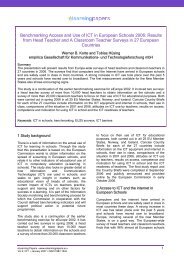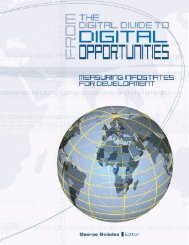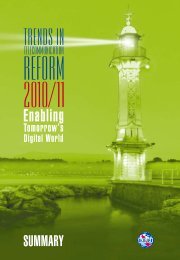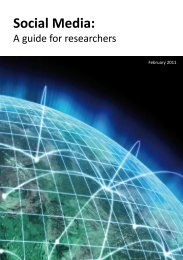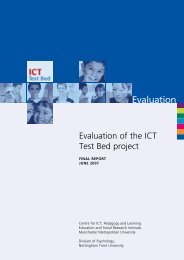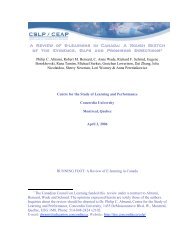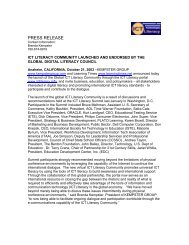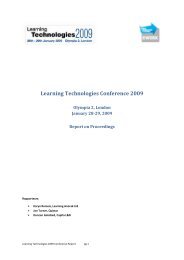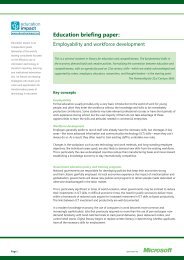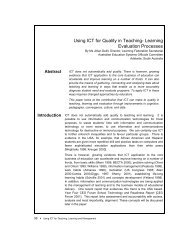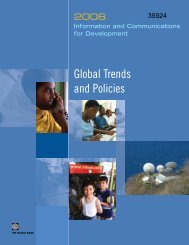The Digital Opportunity Index (DOI) - ITU
The Digital Opportunity Index (DOI) - ITU
The Digital Opportunity Index (DOI) - ITU
Create successful ePaper yourself
Turn your PDF publications into a flip-book with our unique Google optimized e-Paper software.
3.1 Using the <strong>Digital</strong><br />
<strong>Opportunity</strong> <strong>Index</strong> (<strong>DOI</strong>)<br />
<strong>The</strong> <strong>Digital</strong> <strong>Opportunity</strong> <strong>Index</strong> (<strong>DOI</strong>) has been<br />
designed to as a tool for tracking progress in<br />
bridging the digital divide and the implementation<br />
of the outcomes of the World Summit on the<br />
Information Society (WSIS). As such, it provides<br />
a powerful policy tool for exploring the global<br />
and regional trends in infrastructure, opportunity<br />
and usage that are shaping the Information<br />
Society. 1 As explained in Chapter one, the <strong>DOI</strong> is<br />
one of two tools adopted by WSIS as part of an<br />
agreed implementation methodology. It has a<br />
focus on the adoption of new technologies, such<br />
as broadband and mobile Internet. A time series<br />
has been developed to monitor implementation<br />
of WSIS targets since the first phase of WSIS and<br />
will continue until the WSIS review in 2015 (see<br />
Data Table 3). 2 <strong>The</strong> <strong>DOI</strong> thus complements the<br />
other WSIS-endorsed composite index—the ICT<br />
<strong>Opportunity</strong> <strong>Index</strong>—which has a stronger focus<br />
on traditional ICTs, such as fixed-lines and televisions,<br />
as well as on measures of literacy and educational<br />
achievement. 3<br />
This chapter explores key trends in the Information<br />
Society. Section 3.2 explains the structure of the<br />
<strong>DOI</strong> and indicators that are used to assess digital<br />
opportunity. Section 3.3 examines the latest<br />
<strong>DOI</strong> scores and rankings, for 2005/06. Section 3.4<br />
reviews trends in the <strong>DOI</strong> over time. Section 3.5<br />
uses the <strong>DOI</strong> to examine the key trends shaping<br />
the Information Society. It shows that many parts<br />
of the developing world are making strong gains<br />
in mobile telephony. By the end of 2008, over half<br />
the world’s population should have access to a<br />
mobile phone. Meanwhile, however, developed<br />
countries are forging ahead with new technologies<br />
and ever-faster access. As shown in Chapter<br />
two, the digital divide is changing from inequalities<br />
in basic availability of ICTs to differences in the<br />
quality of the user experience. Policy-makers need<br />
to adjust their policy responses to take account of<br />
“quality”, not just the “quantity” of access to ICTs.<br />
3.2 Structure of the <strong>DOI</strong><br />
<strong>The</strong> <strong>DOI</strong> is a composite index comprising eleven<br />
separate indicators, grouped in three clusters<br />
of <strong>Opportunity</strong>, Infrastructure and Utilization<br />
(Figure 3.1d). 4 <strong>The</strong> choice of indicators is notable, as:<br />
» <strong>The</strong> <strong>DOI</strong> includes price data for mobile<br />
telephony and Internet access relative to local<br />
incomes to reflect the affordability of ICTs and<br />
whether consumers can pay for mobile phone<br />
or Internet access in different countries. <strong>The</strong><br />
<strong>DOI</strong> is the only index to date that includes<br />
price data for 181 economies, which is vital in<br />
assessing effective market demand.<br />
» <strong>The</strong> <strong>DOI</strong> uses household penetrations (rather<br />
than per capita penetrations) for fixed lines,<br />
Personal Computers (PCs) and Internet access,<br />
as access to ICTs often begins in the home.<br />
Household penetration is appropriate for<br />
fixed lines, as they are provided on a household<br />
basis, while home access to the Internet<br />
is significant in many countries (Figure 3.7).<br />
Using household penetrations reflects more<br />
accurately the true state of access to ICTs in<br />
developing countries, where average family<br />
size is larger, so per capita penetrations<br />
appear artificially suppressed and are lower.<br />
» <strong>The</strong> <strong>DOI</strong> includes measures of more advanced<br />
technologies in broadband access (for both<br />
fixed broadband access and mobile broadband<br />
or 3G). This means that the <strong>DOI</strong> can<br />
reflect the startling growth in these markets.<br />
It can also be used to assess market maturity,<br />
in the proportion of Internet and mobile subscriptions<br />
that have migrated to high-speed<br />
broadband access (see Figure 3.4 on the “New<br />
Substitution”).<br />
Indicators in various data series are standardized<br />
on a scale of zero to one, by indexing relative to a<br />
reference value (data series and reference values<br />
are given in the Annex to this Chapter). For most<br />
indicators, this is 100 per cent, making the <strong>DOI</strong><br />
simple and straightforward to calculate (simply<br />
dividing the indicator value by 100). <strong>Index</strong> scores<br />
in the three clusters are then averaged by simple<br />
average to give the overall <strong>DOI</strong> score for a country,<br />
between zero and one (no country achieves the<br />
upper or lower limit scores). Scores are directly<br />
comparable between countries and between<br />
years.<br />
<strong>The</strong> results are remarkably straightforward and<br />
easy to use. Access to and the affordability of ICTs<br />
is condensed into a single index number between<br />
one and zero, permitting comparison of countries’<br />
scores in any one year, as well as over time. A time<br />
series has been established, stretching back to the<br />
start of the WSIS process in 2000/01. This Report<br />
presents the latest results for the <strong>DOI</strong> 2006 (Data<br />
Table 1 in the Statistical Annex). As explored in<br />
the next section, results for the <strong>DOI</strong> show strong<br />
gains in digital opportunity around the world.<br />
World Information Society Report 2007<br />
35



